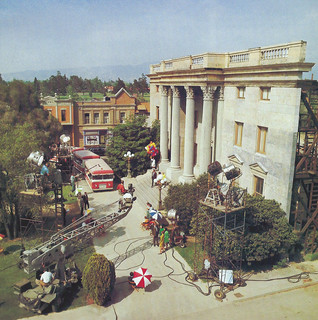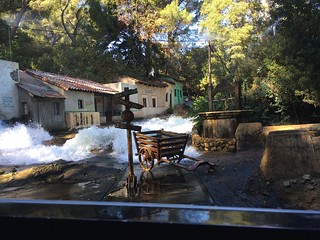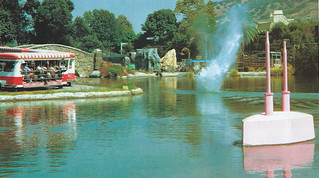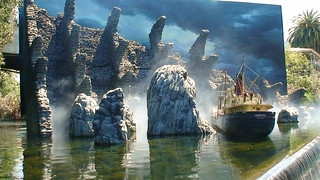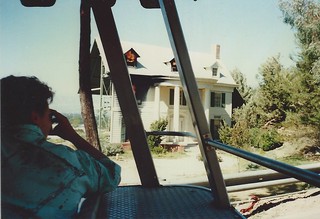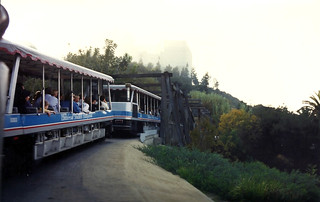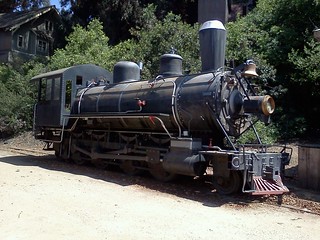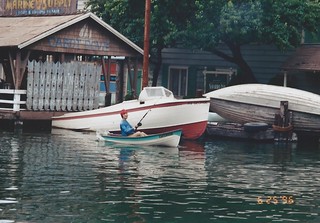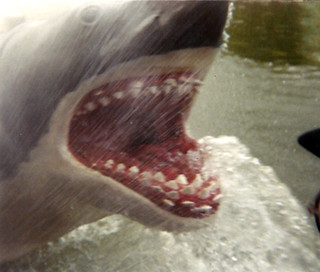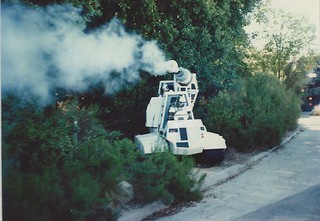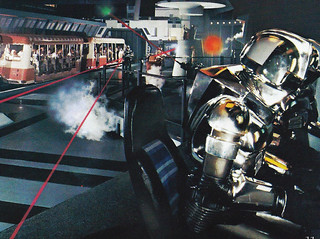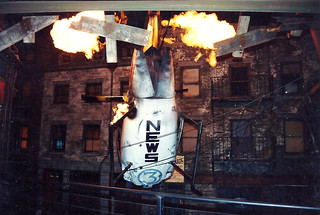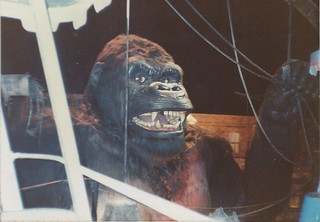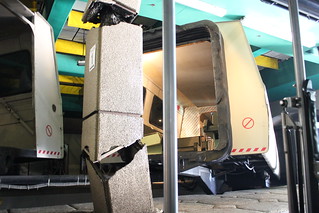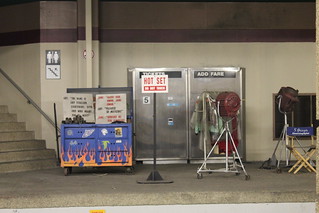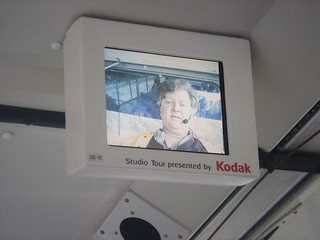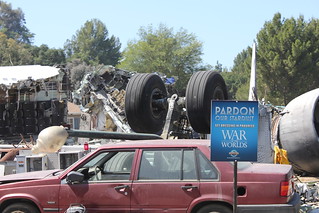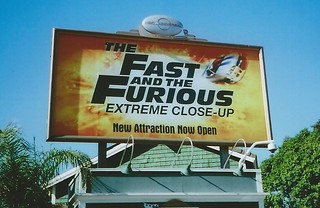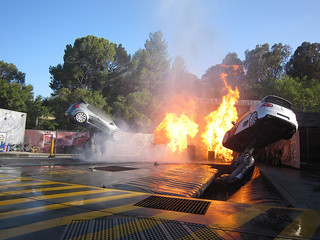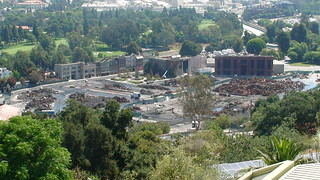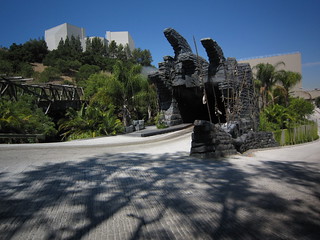July 15, 2014 – Today marks the 50th anniversary of the Studio Tour.
As we look down memory lane, here are just a few of the more prominent developments that occurred within Universal’s flagship attraction.

Since its inception in 1912, Universal always been known for the unprecedented move of inviting the public onto its property for a special look at the movie-making process. In the early days of the studio, guests could wander through the backlot, buy lunch and cheer (or boo) their favorite actors.
However, with the advent of talking pictures in the 1920s, Universal closed the lot from public access for nearly forty years. It wasn’t until 1964 when then MCA/Universal president Lew Wasserman – known for his frugality and concern with the bottom line – spearheaded the relaunch of the Universal Studio Tour program as a possible profit-making venture, bringing guests back to the Universal backlot.
With the iconic red and white Glamor Trams as the primary mode of transport around the backlot, the first iteration of the Studio Tour gave guests remarkable freedom to roam around the studio with little limitation as long as it did not interfere with production. As a result, guides would take guests to empty soundstages or sets that were typically fresh off of production – resulting in a tour that would change dramatically on a day-by-day basis. Indeed, despite the lack of any defined tour animations during this era, guests were still enamored with the inner workings of a large studio backlot.
In this instance, the Studio Tour – for many individuals – became their first behind-the-scenes look at how movies were made. More importantly, the Studio Tour became the birthplace of Universal Studios Hollywood, popularizing the concept of a theme park modeled after a real working movie studio.

With attendance for the new-found Studio Tour growing at a steady pace, studio executives began looking into the concept of an attraction built specifically for their new studio addition.
While previous efforts had been made to entertain guests aboard the the tram (mostly on an untrained, ad-hoc basis), nothing had ever been created on the Universal backlot that could symbolize the remarkable nature of special effects. With the notion that special effects could be spontaneous, dramatic and most importantly autonomous, studio executives opened up the very first tour animation known as the Flash Flood back in 1968.
Set in a sleepy Mexican village, Flash Flood symbolized the true power of special effects – not only showcasing the studio’s capacity to control all aspects of production (including the weather), but also the remarkable instance of a set resetting just in time for the second take. In the case of Flash Flood, the entire set could be reset in less than five minutes – an impressive feat back in the 1960s.
While not rooted in a specific film or franchise, Flash Flood evidently paved the way for the next decade of Studio Tour animations – all of which were built on the premise that any environment across the world could be recreated on the Universal backlot and transformed into a set suitable for filming.

Based somewhat loosely on Universal’s 1959 comedy Operation Petticoat, Torpedo Attack became the studio’s next tour animation, using the site of McHale’s Navy and the Creature from the Black Lagoon to launch patrons in the middle of a water environment.
With a pink somewhat comedic submarine hovering in the distance “triggering” the explosion, the torpedo explosion would evidently create a thirty foot air charged geyser that could be detonated on cue. While nothing major in its own right, Torpedo Attack would eventually set the stage for the Red Sea – creating the infamous beneath-the-sea water effect.

While an admittedly interesting premise for the tour, Torpedo Attack was short lived, eventually succumbing to the Red Sea effect based on Charlton Heston’s famous film The Ten Commandments. While the explosion remained up until the late 1990s, the pink submarine was scrapped soon after the Red Sea’s takeover, leaving guests with an unfettered view of the surrounding lake beneath sea level.
Today, the site most notably serves as the home of the miniature SS Venture designed for Universal’s blockbuster 2005 film King Kong designed by Weta Workshop.
Also introduced during the same year was the Burning House. While certainly unremarkable by today’s standards, the Burning House served as one of Universal’s first public demonstrations of pyrotechnics.

Constructed in 1974 as Universal’s most expensive attraction at the time (totalling around $700,000), Rockslide rested on a simple premise: what would happen if a rocky hill dislodged itself right next to the tram?
Using Styrofoam rocks hoisted via a large bucket above, the attraction would activate by dumping a bucket of rocks towards tram patrons below – with the rocks rolling up to 100 feet downhill until landing in a trough below. However, in true Hollywood fashion, most of the rocks didn’t follow their intended roles – hitting the occasional guests in the head.

Modeled off an old rickety bridge, the Collapsing Bridge began its life in the same vain as the Flash Flood – an attraction premised on a generic demonstration of Hollywood special effects.
In this instance, the tram would drive over a seemingly unstable bridge, only to have it buckle twice under the weight of the tram. As the tram finished its wrap around the lake, the bridge would magically reconstruct ready in time for its next group of guests. While its usage has subsided over the years with the addition of King Kong 360 – 3D, guests can still cross the bridge in the event of another tour animation closure. However, in this case, the Collapsing Bridge slated for demolition – while you’re crossing it!

Constructed as a simple tour animation sought to thrill guests with the threat of a rushing train, the Runaway Train took place along Denver Street. With a train fast approaching, the train would magically stop just feet away from the tram. While the attraction remains long gone, guests can still see the remains of the Runaway Train by simply crossing Denver Street.
Also built during the same year was the famous Ice Tunnel-turned-Mummy’s Tomb. Built using large rotating cylinders, the tram would evidently drive through a tunnel with the constant threat of an avalanche piling through. While remarkably simple, the Ice Tunnel would eventually live until 2013 as the cursed site of the Mummy’s Tomb, until succumbing to the construction of Fast and Furious: Supercharged.

Beginning the trend of movie-based tour animations, Jaws signaled Universal’s first big foray into the modern day theme park attraction – thrilling guests with the premise that a shark could literally pop out at any moment.
Set in a quaint representation of Amity Island, Bruce the shark would signal his intentions by consuming his very first victim right in front of studio patrons. With the tram rushing to hide behind a loading dock, Bruce would evidently tear the pier apart and lash out at each specific section of the tram – popping his head out a total of four times before swimming backwards back to his home.
While incredibly archaic by today’s standards, Jaws ushered unprecedented growth to the Studio Tour as patrons lined up to see the fearful shark in person – signaling to Universal executives that a tour (and perhaps even a theme park) could be a profit inducing venture.

Based off of the television show of the same name, Battlestar Galactica replaced the Rockslide as Universal’s next tour animation.
Placing the tram in the middle of a galactic battle between Cylons and humans, the tour animation would feature a spectacular showing of lights, lasers and animatronics – featuring a live actor to help defend the tram.
With a budget of nearly $2 million, Battlestar Galatica would ironically replace Rockslide (both physically and in rank) as Universal’s most expensive attraction to date, forcing the studio to build in all-new indoor enclosure to house the new animation and its complicated robotics.

Built in collaboration with the 1986 film King Kong Lives, King Kong arguably became the studio’s first immsersive experience – transforming Universal Studios Hollywood from a simple tourist destination into the makings of a full-fledged theme park.
Featuring the largest animatronic figure at the time, King Kong was a technological innovation – pushing the skills and techniques brought upon by Battlestar Galactica in full force. While Battlestar only featured rudimentary robotics, Kong featured a complete recreation of Kong towering next to a New York City bridge. Indeed, the success of the Kong project eventually set the stage for the development of Universal’s first independent theme park, Universal Studios Florida.
Unfortunately, as luck would have it, King Kong – the birthplace of Universal Parks and Resorts – would perish in a fire in 2008, eventually setting the stage for King Kong 360 – 3D.

Building upon the complexity and success of King Kong, Earthquake sought to recreate the famous subway scene from Universal’s 1974 film Earthquake.
Transporting guests to a Northern California subway system, Earthquake featured the use of a high powered hydraulics used to tustle the tram back and forth – simulating an 8.3 on the Richter scale. As the earthquake would intensify, the second story (simulating a typical San Francisco street) would eventually collapse through – revealing a downed power pole alongside a tank truck spewing flames. With the earthquake finally subsiding after a minute of intense shaking, a broken water main would conclude the demonstration by flooding the tram with water.
The premise of Earthquake – The Big One – along with Jaws and King Kong – was so strong that studio executives would eventually recreate the experience in a more elaborate fashion with the opening of Universal Studios Florida in 1990.

With Kodak’s sponsorship in tow, Universal began adding personal monitors in every tram, allowing guests to see their guides firsthand.
The addition of monitors, coupled with the upgrade in sound, allowed guides to add a touch of multimedia to the tour – accompanying the tour of Universal Studios with exclusive clips, trivia and behind-the-scenes footage.
The Studio Tour would upgrade its monitors yet again to accommodate high resolution video in 2010 in preparation for King Kong 360 – 3D.

Set as the crash site for Steven Speilberg’s blockbuster film War of the Worlds, set designer Rick Carter sought to recreate the site of an alien invasion in an average suburban neighborhood.
In order to do just that, film makers purchased a Boeing 747 and dismantled it specifically for the film – creating the iconic scenery many guests see today

Built to take advantage of the fervor surrounding Fast and Furious: Tokyo Drift, Fast and Furious: Extreme Close-Up was originally intended to demonstrate the use of KUKA arms in a theme park environment.
However, after numerous safety restrictions and repeated budgetary concerns, the final product resulted in a tour animation that was questionable at best. Built on the notion that Studio Tour patrons were about to witness a demonstration involving practical and digital effects, the demonstration involved the use of two Volkswagen launched in the air in a fiery explosion. When the demonstration concluded, the cars would dance to the tune of Daddy Yankee’s Gasolina.
Again, this was all questionable at best.

While Universal has had fires in the past, none have been so devastating as the fire that ravaged the lot in 2008.
Indeed, on June 1, 2008 at approximately 5:00AM, a fire broke out onto the Universal Studios metropolitan sets and destroyed several acres of the lot including the famed 1986 King Kong attraction. While the damage was catastrophic, the restoration process was quick – ushering in a new era of sets for Universal’s famed metropolitan district.

Constructed in 2009, King Kong 360 – 3D would spearhead the growth of Universal Studios Hollywood after years of dormant activity. While shows were added to the park’s roster, none had resonated with guests to the same level of Kong. And in an odd twist of fate, King Kong 360 – like the original Kong attraction – jumpstarted a new era of unprecedented growth for the theme park, signaling a new period of investment.
Built to replace the original King Kong attraction that was tragically lost in the 2008 backlot fire, King Kong 360 3D employs two massive screens, measuring 187 feet wide by 40 feet high. Using 16 high resolution projectors, Universal reemployed King Kong director Peter Jackson to create another chapter in the blockbuster film, recreating the infamous tyrannosaurus rex scene from the original King Kong film.

With Universal opening Fast and Furious: Supercharged in 2015 alongside the introduction of nighttime tours, 2015 is poised to be the year of the Studio Tour. Stay tuned as we continue our celebration of Universal Studios Hollywood.
Of course, special thanks must go out to theStudioTour.com for their fine chronology of Universal proper. Be sure to visit their website to get a different take on the studio aspect of Universal Studios.


